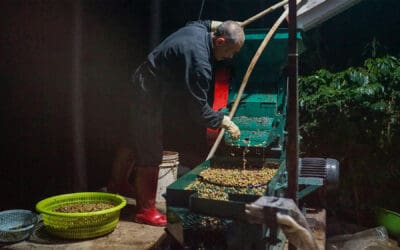Variations in the fermentation at the coffee processing stage yields a range of surprising results.
Just as no two bean varietals or crop harvests are the same, the grower has significant control over the underlying flavour profile through the processing method chosen. Of the top methods (natural, washed, honey processed and a variety of experimental methods), honey processing contains a further three subcategories within it, each worthy of a deeper discussion.
It’s worth noting that the name, honey processing, can be misleading. honey is not used or added. The key distinction lies in how much mucilage (the sticky, sugar-rich fruit layer) is left on the bean during drying, which directly affects the final flavour profile. Let’s consider each in turn:
Yellow Honey (White Honey in some regions)
- Only 0-25% of mucilage remains
- Fastest drying time (7-10 days)
- Lightest, brightest cup profile
- Most similar to washed coffees
- Clean, sweet with moderate body
- Lower risk of fermentation defects
Red Honey
- About 50-75% mucilage remains
- Medium drying time (14-21 days)
- More pronounced sweetness
- Fuller body than yellow honey
- Enhanced fruit notes
- Requires more careful monitoring during drying
Black Honey
- 100% mucilage left on
- Longest drying time (up to 30 days)
- – Most complex and intense flavour profile
- Heaviest body
- Most fruit-forward character
- Highest risk of defects if not carefully managed
- Most labor-intensive process
A key technical point: The “colour” names actually come from how dark the beans become during drying – the more mucilage left on, the darker they turn due to oxidation. The increased sugar content and longer drying times result in more complex chemical reactions, which create deeper, more nuanced flavour compounds.
Temperature and humidity control become increasingly critical as you move from yellow to black honey processing, as the higher mucilage content makes the beans more susceptible to mold and uneven drying.
So you see, there is considerable latitude to affect different flavour profiles so long as the processor is conscious of the molding hazard and the potential for spoiling the entire batch. As a green bean (pre-roasted coffee) customer, the product will have passed through a number of hands before reaching you. Still, it is important you monitor your beans for spoilage and adhere to proper storage protocols.
Are you a coffee roaster (commercial, or at-home)? If so, I would love to hear about your experiences, particularly as it relates to honey processed beans. Let me know in the comments. And be sure to subscribe to The Coffee Authority Weekly. Community input enriches the brew.



0 Comments